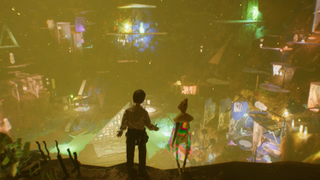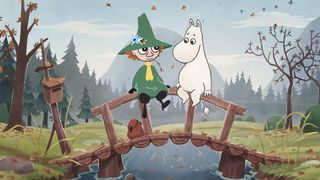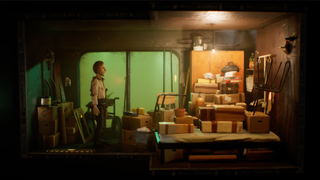Harold Halibut's gorgeous handmade stop-motion world feels totally worth the wait
Preview | Developer Slow Bros. spent over a decade making the stop-motion game

Some years back, I had the opportunity to play a short demo of Harold Halibut, a game I hadn't heard of previously. It was a remote opportunity, part of the Tribeca Games Festival, and therefore was immediately and obviously janky even before the various bugs inherent to early builds crept in. And yet the stop-motion aesthetics, physical sets, and dry humor of the game hooked me from the jump in a way few things have ever done. And now that I've finally played a version of Harold Halibut that's so very close to release on my own computer, I think it's fair to say that my previous infatuation has blossomed into well-deserved love.
My only caveat here is that, of course I love Harold Halibut. I'm personally drawn to overly ambitious works that maybe stumble here and there rather than technically perfect ones that lack a certain passion. I'll take a swing for the fences over a bunt every single time, and developer Slow Bros. spending more than a decade trying to build an adventure game with physical models and sets is absolutely the former regardless of how you feel about the end result.
Harold Halibut is, at its heart, an adventure game. It's not quite point-and-click as you can rumble around in 3D space, but it's functionally about talking to people, solving puzzles/problems, and ticking off a list of various day-to-day tasks that range from feeding fish to fixing a 3D printer that's seemingly not even broke – the guy just wanted you to get shocked when touching a sparking wire inside.
Go motion


Love indie games? Check out our weekly Indie Spotlight column for great lesser-known gems you can play right now
As for how the scans of the physical models all interact with each other considering the player has significant control over Harold, the short version is that it all works better than you might expect while also occasionally creating clear hiccups. Harold's feet clearly aren't exactly touching the stairs quite right when it climbs them, for example, and a toilet door that can swing back and forth is a nice little touch until players get right up on it and quickly move back and forth, sending it clipping wildly around the bathroom before snapping back into its original position.
There's a physicality and tactile-ness to Harold Halibut that's hard to overstate. This is obviously one of the big aspects of the game, and clear from the jump, but even then it's another thing to actually experience. Every little thing has a texture, and all the models have seams and so on. The setting is fantastical, and farcical, but it never feels like Harold Halibut is anything but realistic.
Looking at a scene playing out, there's a feeling that the animators are just outside of the shot, waiting to swap in a new mouth to capture another part of a second of dialogue. It's not quite true, but it evokes that feeling constantly, which is an achievement in and of itself. It's not chasing photorealism by any metric, but the blood, sweat, and tears behind the effort to really make Harold and his world constantly pays dividends. There's a reason that there's a dedicated button to zoom in, allowing you to take in all the smallest details.

"Or maybe it's an opportunity to simply admire the craft behind the floor below them, a small sliver of which is visible despite the fact that the developers actually physically made the entire floor itself"
The meticulous environments and charming dialogue go a long way to making what is effectively wandering back and forth across a lot of the same environments over and over enjoyable. What could become a slog is instead an opportunity to hear two characters at a table providing narrative exposition in the goofiest way possible by regularly discussing whatever it is you've just learned about or have next on your task list. Or maybe it's an opportunity to simply admire the craft behind the floor below them, a small sliver of which is visible despite the fact that the developers actually physically made the entire floor for the place. In my case, it's both, and I expect it will be for many others.
Sign up to the GamesRadar+ Newsletter
Weekly digests, tales from the communities you love, and more
Admittedly, I don't know how Harold Halibut ends, though the developers have indicated that there are several possible endings available. I can only really speak to my experience of the earliest chapters of the game. But if the rest is anything like what I've played and comes anywhere close to sticking the landing, I have a sneaking suspicion that I'll be arguing with folks about its positioning in relation to much, much bigger games come December.
Here are some great upcoming indie games for 2024 and beyond

Rollin is the US Managing Editor at GamesRadar+. With over 16 years of online journalism experience, Rollin has helped provide coverage of gaming and entertainment for brands like IGN, Inverse, ComicBook.com, and more. While he has approximate knowledge of many things, his work often has a focus on RPGs and animation in addition to franchises like Pokemon and Dragon Age. In his spare time, Rollin likes to import Valkyria Chronicles merch and watch anime.
Most Popular



